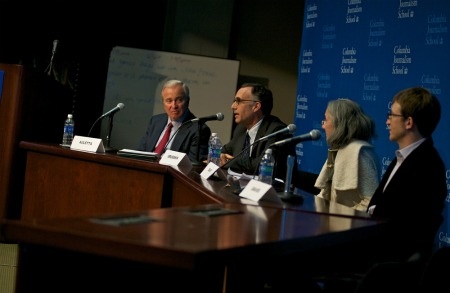Ken Auletta introduced Tuesday night’s panel discussion at the Columbia University Graduate School of Journalism by saying “We’re going to talk tonight about a report that is about the end of the world as we know it.” He was moderating a talk with the authors of “The Story So Far: What we know about the business of digital journalism”: Bill Grueskin, Ava Seave, and Lucas Graves.

The report explores the upending of traditional business models of the news industry, brought on by technological and financial shifts in the past decade and a half. But it’s not all bleak: the authors conclude their research with recommendations for the future and some surprising examples of success and profit. Which were, of course, what Auletta and his audience were most eager to hear about. “So,” Auletta asked Lucas Graves, Ph.D. candidate at Columbia, “what works?” Graves responded with a laugh, “Why do I get the hard question?”
Graves did answer, though: he spoke about The Batavian, a small local news site in an upstate New York town that, by charging a very small amount of money for display ads, has attracted a large volume of advertisers. Without much overhead and practically no infrastructure costs, the publisher was able to make about $125,000 last year—more than it cost to run the site. Later, he also mentioned Alaska Dispatch, an online-only site that has won recognition for its serious coverage of state politics. While it launched with a large budget for its size, funded by an initial grant, it is on track to be financially self-sustained by ad revenue within the year.
Seave also cited New York magazine as an interesting case; it’s an outlet with print origins, but one that has attracted a huge amount of web traffic to its offshoot websites, most of which feature web-only content rather than stories from the print version. About 33 percent of its ad revenue is from the digital side, said Seave, which is a very high proportion. And 86 percent of its traffic online is accounted for by original, web-only content, whether it’s commentary, video, or their extensive restaurant listing database. The panel agreed that this was an example of a news outlet that has successfully embraced the web as a different medium altogether, rather than just uploading pieces from the print product and expecting readers to follow.
As for larger legacy news organizations, Grueskin mentioned the Hearst paper the Houston Chronicle and its website, chron.com as another successful experiment. Rather than just selling traditional ads to local businesses in its own paper, the Chronicle recently created an internet service that reaches out to small businesses to help them market themselves in many different ways: by creating websites for them, for example, or by teaching them about social media and search engine optimization. In just the first few months, this team at the Chronicle has already booked 2 to 3 million dollars in contracts, Grueskin said. But beyond that initial surge of revenue, he noted, “More importantly, they are building ties to companies that felt that they didn’t have any connection to the Chronicle anymore.”
For more examples like this, the full report is available, along with supplementary essays and Q&A’s to be published as we feature each chapter, here. And a video an audio recording of the event is available on the Columbia J-school website, here.

